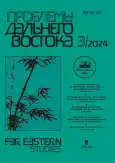Features of Indonesia’s Low-Carbon Development Strategy
- Authors: Ershov D.N.1
-
Affiliations:
- Financial Research Institute of the Ministry of Finance of the Russian Federation
- Issue: No 3 (2024)
- Pages: 101-111
- Section: Environment
- URL: https://gynecology.orscience.ru/0131-2812/article/view/676323
- DOI: https://doi.org/10.31857/S0131281224030071
- ID: 676323
Cite item
Abstract
The purpose of the article is to identify trends and features of the development of a low-carbon economy and climate control tools in Indonesia using methods of content analysis, quantitative and comparative assessment. Climate goals declared for the period up to 2030 and 2050 are analyzed and there has been a rise in climate ambitions, based largely on measures to decarbonise the land and forestry sector. The peculiarity of Indonesia's climate goals is that they are defined relative to a business-as-usual scenario, which assumes the current rate of growth in greenhouse gas emissions and are calculated subject to the provision of international financial assistance. The long-term strategy for low-carbon development until 2050 is considered and government priorities in the field of climate regulation are identified. While forced to maintain coal generation as its long-term energy backbone, Indonesia is seeking to pursue other avenues: introducing carbon pricing, incentivizing renewable energy, increasing production of electric vehicles, and developing and deploying carbon capture technology. By providing state support to priority areas, Indonesia actively takes advantage of the opportunities provided by international financial organizations to finance climate projects. It is concluded that the long-term low-carbon development strategy and associated climate goals in terms of greenhouse gas emissions and the time frame for achieving carbon neutrality are quite moderate, since they are based on a comparison with the business-as-usual scenario. With this approach to strategic planning, it will be possible to achieve the set goals by implementing measures only in the land and forestry sector, while the volume of greenhouse gas emissions in other sectors may not decrease, but increase in absolute terms. This approach is explained by national interests and the desire to preserve coal generation in the energy sector.
About the authors
Dmitry N. Ershov
Financial Research Institute of the Ministry of Finance of the Russian Federation
Author for correspondence.
Email: ershov@nifi.ru
ORCID iD: 0000-0002-7624-4648
Ph.D. (Physical & Mathematical Sciences), Senior Researcher
Moscow, RussiaReferences
- Астафьева Е.М., Петрова О.Л. Глобальное изменение климата: последствия для Индонезии // Юго-Восточная Азия: актуальные проблемы развития. 2021. Т. III. № 3 (52). С. 107-115. doi: 10.31696/2072-8271-2021 -2-2-51-107-115
- Батаева Б.С. Реализация мер по декарбонизации экономики Индонезии в интересах устойчивого развития // Право и управление. XXI век. 2023. № 3 (68). С. 64-76. doi: 10.24833/2073-84202023-3-68-64-76
- Золотухин И.Н., Журбей Е.В., Куква Н.М. Опыт экологической политики Индонезии: уроки, проблемы и решения // Ойкумена. Регионоведческие исследования. 2019. № 4 (51). С. 83-97. doi: 10.24866/1998-6785/2019-4/83-97.
- Ковалевская А.С. Особенности обеспечения устойчивого развития и «зеленого» роста в Индии, Индонезии и Китае // Экономика предприятий, регионов, стран: актуальные вопросы и современные аспекты. Сборник статей VI Международной научно-практической конференции. Пенза. 2021. С. 142-150.
- Никулина С.И. Формирование национальной модели «зеленой» экономики в Индонезии: особенности стратегического планирования и государственной поддержки // Экономика и управление. 2021. № 27 (5). С. 336-345. doi: 10.35854/1998-1627-2021-5-336-344
- Andriansyah Hong S.H. Cap First, and Then Tax: Carbon-Pricing in Indonesia // ASEAN +3 Macroeconomic Research Office. April 21, 2023. URL: https://www.amro-asia.org/cap-first-and-then-tax-carbon-pricing-in-indonesia/ (дата обращения: 04.03.2024).
- Bachtiar R., Tobias E. Indonesia Introduces CCs and CCUS Regulations // Arma-Law. 2023. URL: https://www.arma-law.com/news-event/newsflash/indonesia-introduces-ccu-and-ccus-regulations (дата обращения: 04.03.2024).
- Edianto A.S. JETP: a reflection of Indonesia’s commitment to transform its power sector // Emberclimate. January 26, 2023. URL: https://ember-climate.org/insights/commentary/jetp-indonesia/ (дата обращения: 04.03.2024).
- Mahalana A., Posada F. Will Indonesia’s Ambitious Plan To Subsidize Evs And Hybrids Benefit Everyone? // ICCT. 3 March, 2023. URL: https://theicct.org/asean-indonesia-evs-mar23/ (дата обращения: 04.03.2024).
- Pratama R.A. Indonesia to Receive Largest Amount of GEF's Climate Finance Funds // Earth Journalism network. November 19, 2022. URL: https://earthjournalism.net/stories/indonesia-to-receive-largest-amount-of-gefs-climate-finance-funds (дата обращения: 04.03.2024).
- Roesad K. Indonesia’s underwhelming renewable energy reform // East Asia Forum. April 11, 2023. URL: https://www.eastasiaforum.org/2023/04/11/indonesias-underwhelming-renewable-energy-reform/ (дата обращения: 04.03.2024).
- Sambodo M.T., Yuliana C.I., Hidayat S., Novandra R., Handoyo F.W., Farandy A.R., Inayah I., Yuniarti P.I. Breaking barriers to low-carbon development in Indonesia: deployment of renewable energy // Heliyon. 2022. Vol. 8. Iss. 4. doi: 10.1016/j.heliyon.2022.e09304
- Yakovlev I.A., Nikulina S.I. Indonesia’s Strategy for Sustainable Finance // Financial Journal. 2019. No. 6. Pp. 83-95. doi: 10.31107/2075-1990-2019-6-83-95
Supplementary files








